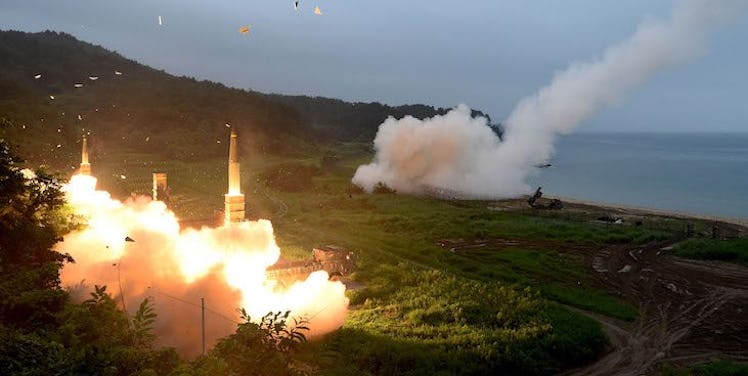
If North Korea Fired Missiles At The U.S., Here's Where They Might Hit
It's the Cold War Part II: North Korea Style. Sadly, that's not a movie title, but rather the current state of affairs in American politics. After President Donald Trump threatened North Korea with a retaliation of “fire and fury” if the nation continued its threats against America, North Korean state media announced that the nation was considering attacks on nearby U.S. territories, or even the mainland. Which leaves everyone wondering: Is it even possible, and where could North Korean missiles hit the U.S.?
The answer is, maybe; and a few places.
But don't go running for your underground bunker yet. Here's what you need to know if North Korea decides to attack the United States.
North Korea has already picked out a number of targets.
North Korea has long made a hobby of threatening the continental United States. And though the threats have rarely been taken seriously, it hasn't stopped the nation from choosing where it would send its bombs. Analysis of a map of the United States featured in North Korean propaganda photos appeared to show a number of targets in the United States, according to The Washington Post.
The map, seen in the background of a photo of Kim Jong Un conferring with military officers, showed lines which seemed to originate from Asia and finish in a number of U.S. locations: Hawaii, San Diego, and Washington D.C. Another partially obscured line appeared to connect to Barksdale Air Force Base in Louisiana.
With reports that North Korea recently tested a missile with a range that might be far enough to hit Los Angeles, Denver, or even Chicago, per the Associated Press, those targets are suddenly far more feasible.
Of course, this doesn't count U.S. territories like Guam, which is well within the range of North Korean missiles, or the various military bases stationed in South Korea and Japan.
Military targets and the West Coast might be most at risk.
The West Coast, and particularly Hawaii, are simply easier for North Korea to reach.
The range a missile travels depends on how heavy the warhead inside it is — the bigger the payload, the shorter the trajectory, per CNN. If Korea wanted to deliver a big bomb to the United States, it would have to sacrifice distance to get it there.
The Washington Post also points out that the targets seen on the propaganda map all have a military purpose — Hawaii is home to U.S. Pacific Command, Barksdale Air Force Base has the Air Force Global Strike Command, and San Diego hosts the Pacific Fleet. And of course, in Washington D.C., the Pentagon is the nervous system for the entire U.S. military. If North Korea really intended to attack the United States, wiping out our ability to fight back would be a good first move.
The United States isn't defenseless when it comes to missile strikes.
THAAD, short for Terminal High Altitude Area Defense, is a missile-intercept system meant to stop shorter-range ballistic missiles, and the United States has stations set up in Guam, South Korea, and Alaska. Though THAAD's missiles have a range of only about 125 miles and are not intended to stop intercontinental ballistic missles (ICBMs), keeping a few of the interceptors in a little ring around the Korean Peninsula can't hurt.
The United States also has 36 ground-based interceptors, split between Fort Greely, Alaska, and Vandenberg Air Force Base, California, ready to protect the United States. And back in May, a test of those interceptors successfully stopped an ICBM with a launch from Vandenberg, per ABC. So, we know they're working.
But if you still can't shake the fear, we get it. You can always check out the U.S. government's official guidance on how to survive a nuclear attack. A little preparation never hurt anyone.
Lisa Dunn contributed research to this story.